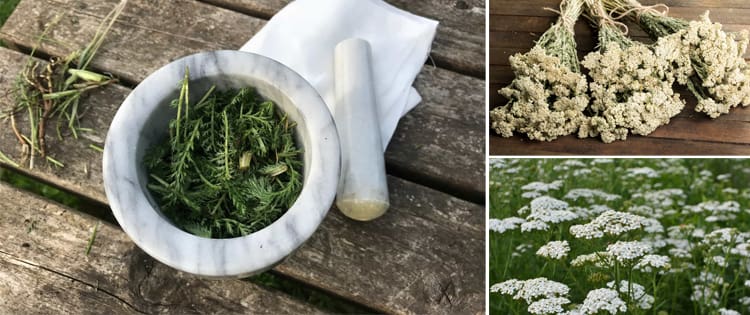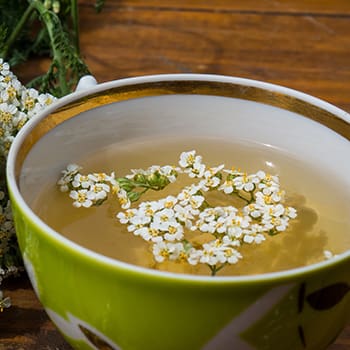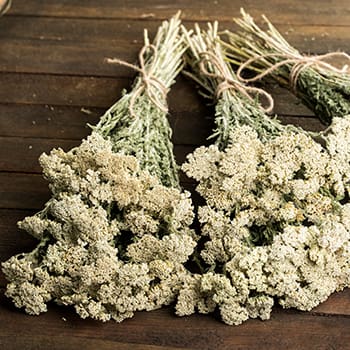Yarrow (Achillea millefolium) is a member of the daisy or Asteraceae family. This perennial plant has numerous common names including, Milfoil, Nosebleed, Woundwort, Thousand-leaf, and – the one most often used today – Common Yarrow.
This plant is enjoyed by gardeners but is also found growing wild in meadows, in wasteland areas, and at the roadside.
While Common Yarrow blooms are white, there is now a multitude of varieties of this species that come in a range of colors. However, this article focuses specifically on Common Yarrow.
Where This Plant Is Found
The broader Yarrow genus is native to temperate regions of Asia, Europe, and North America. It is therefore considered to be native to Eurasia as the spread extends from China to the UK.
It has also been introduced to Australia and New Zealand, initially as a form of livestock feed. It is now naturalized and is found growing wild.
How To Identify Yarrow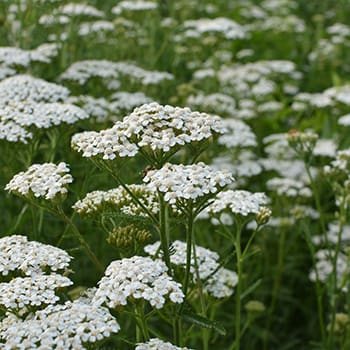
Yarrow is not difficult to identify. One aspect that helps with identification is the scent: it is strong and sweet and described by many as like that of chrysanthemums. The bitter taste is equally powerful. These erect plants at maturity can reach a height of 1 meter / 3 ¼ feet.
Leaf: The leaves are feathery, alternate, arranged spirally, 3 – 20 cm / 1 ¼ – 7 ¾ inches long, and evenly distributed on the stems. The leaves at the base and middle of the stems are larger than the ones higher up. The leaves are hairy.
Stems: The stems are rigid, angular, and fibrous in texture.
Flower: Yarrow blooms from the start of summer through to early fall. The individual blooms form composite flower heads. Each head consists of 15 to 40 small, round, white or pale pink flowers that have yellow centers.
Fruit: The fruits are small and contain seeds.
It is the combination of the feathery leaves and flower heads that make Yarrow easy to spot.
Stop Bleeding
You can dry the herb, stem, and flowers, and grind them into a powder. This powder may be applied to stop excessive bleeding.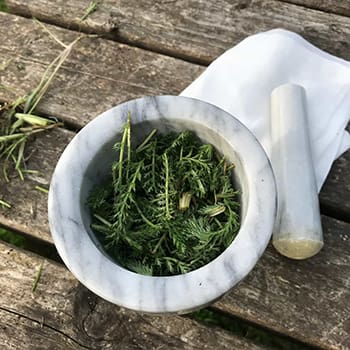
It helps the body produce a clot to prevent fresh bleeding from a deep wound. Alternatively, mash the fresh plant and apply it to a wound to slow bleeding and promote clotting.
Treat Sunburn
Too much time in the sun? Yarrow essential oil or infused carrier oil can be smoothed into your reddened skin. This helps ease the pain and also prevents permanent damage.
Speed Up Healing Of Cuts And Wounds
Yarrow made into an ointment can help your small cuts and scratches heal faster by promoting healing and reducing inflammation. It’s also a natural antibiotic to help prevent infection in the same wounds.
Stop Post-Partum Bleeding
A sitz bath in yarrow tea is ideal for easing bleeding after a woman gives birth.
It is also useful for stopping hemorrhage after birth and helps the tissues to heal faster.
Reduce The Appearance Of Scars
Apply crushed yarrow or a balm made with the healing herb to any scars that you want to be less noticeable.
The twice-daily application can help reduce the appearance of any scars, particularly those on the face.
Eliminate Tooth Pain
Do you have a sore molar? Chew on some yarrow root to help ease the pain. Traditionally, the root is peeled and stored in a jar, covered with rum or brandy. When pain hits, pull out a piece of the root to chew on for stopping the pain.
Lower Blood Pressure
Anyone with high blood pressure knows that it can make you feel anxious and unpleasant. You may feel like your skin is crawling when the pressure rises rapidly. Take a cup of yarrow tea to help pull blood away from the heart and ease the discomfort. Yarrow can ease some of the symptoms of high blood pressure. It also thins the blood.
How To Grow Yarrow
This medicinal plant is easy to grow. All it really wants is the sun. It is not fussy about soil type and does not need a lot of water (although plants in containers need more watering than those in the ground).
You can opt to buy small plants from a nursery or garden center or grow Yarrow yourself from seeds you purchased or harvested from your own or wild plants.
Seeds are planted in spring and shouldn’t be planted deeper than ¼ inch / ½ centimeter. They should be 12 – 18 inches / 30 – 46 centimeters apart to allow the maturing plants the necessary space. The seeds require sunlight and should be kept moist until they germinate. The temperature for germination should be 18 – 240 Celsius / 64 – 750 Fahrenheit.
How To Harvest This Plant
Yarrow can be harvested from your own plants or in the wild. Leaves can be harvested all year and they bloom when they are mature and not beginning to fade or go to seed… unless you want the seeds!
As with any foraging, though, you should first ensure your plant identification is correct and, secondly, that you only harvest in areas where air and soil pollution/contamination is likely to be low. Roadsides, for example, are not good harvesting locations as both the air and ground are likely to carry toxins.
Finally, leave the roots and some basal leaves behind so that the plant can regenerate and survive. This will mean more Yarrow for you and other foragers the following season.
What Parts Of The Plant Are Used In Remedies?
Most of the Yarrow plants can be used. Specifically, the roots, leaves, and flowers are all utilized.
However, the stems or stalks are not useful for remedies and neither are the seeds. In addition, the root is also not used medicinally.
How To Preserve This Plant
Yarrow flowers and leaves are best preserved by drying as this retains their medicinal properties and extends their shelf-life. The drying process is straightforward:
- Spread out the flower heads in a thin/single layer on a drying screen, wire mesh, or suitable cloth
- Place the screen/cloth/rack in a well ventilated and shaded place
- Turn or move the flower heads around regularly so that they are all exposed to air
- When the flowers and leaves are dry (crisp to the touch) place them in airtight and labeled containers
- Store the containers in a dark, dry place.
- Do not wash the flowers as this will greatly increase the chances of the flowers molding or getting mildewed before they dry. If this happens you must throw them away.
Correctly dried and stored, the plant material should stay fresh and potent for up to a year.
Precautions For Taking Yarrow
It is not recommended to take high doses of yarrow over an extended period of time. It contains a compound called thujone which is actually toxic, but it is considered safe to consume occasionally in low doses. Do not ingest yarrow when pregnant as it may cause miscarriage.
If you’re allergic to daisies and ragwort, then there is a good chance that you will also be allergic to yarrow. Some people with sensitive skin or allergies can have issues handling fresh yarrow, which can cause a minor rash when also exposed to sunlight (phytophotodermatitis).
You may also like:
Do You Have This Plant In Your Backyard?
An Ingenious Eggshell Remedy and 25 Others Made from Things People Usually Throw Away (Video)
Why You Should Use Banana Peels In Your Garden
Vertical Garden: 26 Plants To Grow Your Own
A Medicinal Garden Kit For Starting A Small Backyard Pharmacy
